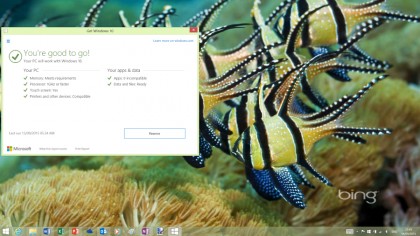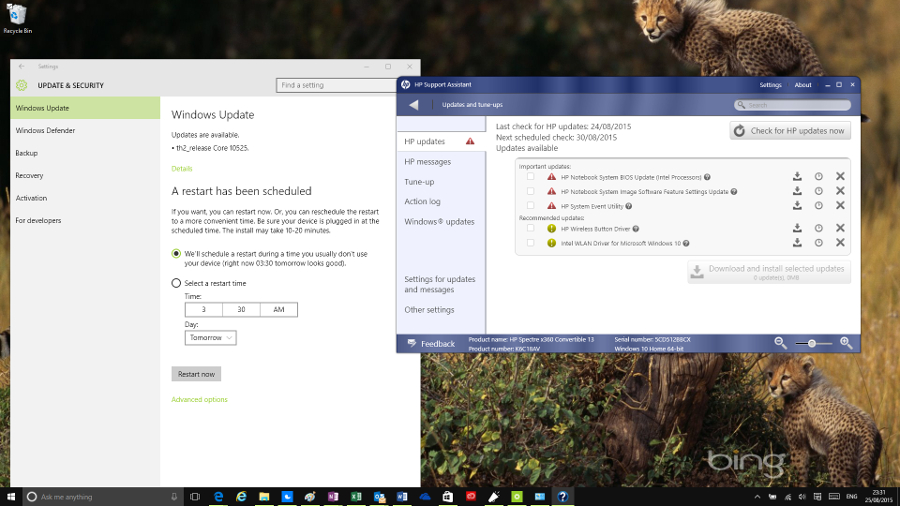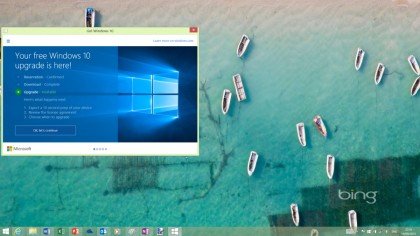Should you upgrade to Windows 10?
Even though it might be a free upgrade, is Windows 10 right for you?

Introduction

If you're using Windows 7 or Windows 8.1, you'll have been seeing that little Windows icon in the taskbar for a while now – the one that reminds you that you can upgrade and install Windows 10. You might have been reading about long-awaited new features – like being able to sync folders on OneDrive that other people have shared with you – that are only available on Windows 10.
However, while there are certainly reasons to upgrade, there are also plenty of reasons to stick with Windows 7 or 8.1, with the first being to avoid the hassle of having to go through the entire upgrade process (and not changing something if it is already working).
So should you upgrade or not? The first thing you might want to do is some groundwork. Have a read of our extensive Windows 10 review which delves into more details about what's new in Microsoft's fresh operating system and how it differs from its predecessors. You might also want to take a look at our Windows 10 vs Windows 8.1 vs Windows 7 article.
Once you're all primed on the topic, head on through our slideshow which addresses the key questions about whether to take the plunge and upgrade.
What you get with Windows 10

For many people, Windows 10 is a great release, that goes beyond just bringing back the Start menu or including a lot of security improvements that businesses will welcome. For starters, it will improve performance on many systems. Windows itself takes up a little less disk space but what you'll notice if you're coming from Windows 7 is much faster boot times and longer battery life (the gains over Windows 8.1 are less impressive).
It also has a new way of handling memory – when programs are asking for more memory than the system has available, rather than copying what other programs have in memory to disk so it can shift that memory to the new application (which will make it slower to switch back to them later), the kernel compresses the contents of memory to make room without slowing things down.
Gaming performance is similar to Windows 7 (and Windows 8.1), but DirectX 12 support means new games will get better performance on existing hardware. Plus you can stream games from your Xbox to your PC to play them and capture snapshots of gameplay in any game to share with friends.
Sign up to the TechRadar Pro newsletter to get all the top news, opinion, features and guidance your business needs to succeed!
If you avoided Windows 8 because of the Start screen, or you just didn't get around to upgrading, Windows 10 is your chance to benefit from a host of improvements. These include more tools in File Explorer and Task Manager, the simple refresh and reset tools that make it easier to fix your PC, having settings automatically sync to other PCs that you use with the same Microsoft account, and the new picture password that makes having a password on your account far less tedious. If you have a new notebook with the Intel RealSense camera built in, Windows 10 makes things even easier by recognising your face.
Other big new features in Windows 10 include Passport, which Microsoft hopes will replace passwords by using that secure logon to give websites and services your credentials – that won't work for a while, because the FIDO Alliance standard it's compatible with isn't quite finished.
Then there's Cortana, the voice assistant from Windows Phone that also powers search in Windows 10, finding programs and files on your PC, suggesting matching apps from the Store and looking up information from the web, all in one place. Cortana is both fun and useful now, and could get a lot more useful as more apps and services integrate with it.
Windows 10 includes free Office apps, although they're more like the Office apps on a phone or tablet than the full version of Office. There's also the new Edge browser – if you want to use sites that don't work in IE, without having to switch to Chrome (which is ever more of a resource hog) or Firefox, Edge is an interesting option, and it's only available in Windows 10. But with no extension support and no ad blocking, Edge is still a work in progress. To a certain extent, that's true of Windows 10 itself.
What you have to get used to with Windows 10

Windows 10 is a free upgrade for the first year to entice you to move up to a new version of Windows that Microsoft can keep improving and updating; that's what Microsoft calls Windows as a Service.
Especially if you decide to be a Windows Insider, that means frequent updates and frequent restarts – and limited information about what's getting fixed or updated each time. You can tell Windows to warn you about restarts and let you pick the time for them, but it's far harder to just hibernate your PC and keep using it for weeks at a time.
The updates are nearly always a good thing; security fixes are important and a lot of attacks use vulnerabilities that have already been fixed – but people haven't installed the patches. However, with Windows 10 Home, you can't avoid getting essential updates – and that might displease some who would prefer to have a choice. If you want to have a PC that doesn't change, you'll need to have a business version of Windows 10 and policies that stop updates.
As with any new version of software, there are still issues with Windows 10, including problems with apps like Mail, and sometimes stability issues on different systems. Not everyone will experience problems (a clean install or a system reset will often make Windows 10 more reliable if you do), and Microsoft is working on the various glitches, but it's a good idea to check what users with similar hardware are experiencing before you upgrade.
You'll also need to get used to having a Microsoft account. It is still possible to create a local account and use that, but you'll miss out on lots of features in Windows 10 – from the Store to OneDrive file sync to Xbox gaming. If you're going to ignore all of that, you'll need a good reason to upgrade to Windows 10 at all.
What you lose with Windows 10

If you don't want to give up Windows Media Center, don't plan to download a crack; skip Windows 10 (or upgrade and find an alternative for the features in Media Center, because otherwise you'll be stuck on an old version of Windows for a very long time).
Also, if you need XP Mode to keep an elderly Windows XP program working, don't upgrade to Windows 10 – or upgrade to the Pro version, and run an older version of Windows virtually using Hyper-V, but remember that you're more likely to have security problems because of that.
It's unlikely that you'll be so attached to Spider Solitaire that you skip Windows 10 to keep it, especially as there are free versions of all the key Windows games in the Store.
But the changes to OneDrive are more significant. If you don't sync all the folders from OneDrive to your PC, you won't be able to work with them in File Explorer any more. If that's key to the way you work, skip the Windows 10 upgrade until Microsoft comes up with the promised features to replace offline placeholders.
- Also check out: Upgrade to Windows 10 and you will lose these 5 features
Is Windows 10 for me?

Any new version of Windows has advantages and disadvantages and Windows 10 is no different – except that the free upgrade for the first year makes it more tempting to go for it without necessarily thinking things through.
Be sure to check how well Windows 10 will work on your PC, and how your various installed programs will cope with it. While one might expect some legacy applications and hardware/peripherals to stop working in Windows 10, we found Microsoft's flagship OS to be particularly accommodating when it comes to old software. We managed to install several decade-old applications without a hitch; the oldest one – Paint Shop Pro 4.12 – was 18-years-old.
Look at the new features Windows 10 offers and decide how useful they are to you, and look at the changes and the features that you'll lose in order to decide if any of those will cause you problems.
And while there aren't any major flaws in Windows 10, if you're worried about the niggles, remember that you don't need to rush – the free upgrade will be available for a year after Windows 10's launch and Microsoft keeps adding improvements and fixes.
If you're on the fence, you can always upgrade and try Windows 10 for yourself and roll back to your previous version of Windows if you subsequently decide it's not for you (just ensure you make a good backup first).
Note that if you ultimately decide not to upgrade, you can always install Windows 10 features on Windows 8.1.
Mary (Twitter, Google+, website) started her career at Future Publishing, saw the AOL meltdown first hand the first time around when she ran the AOL UK computing channel, and she's been a freelance tech writer for over a decade. She's used every version of Windows and Office released, and every smartphone too, but she's still looking for the perfect tablet. Yes, she really does have USB earrings.